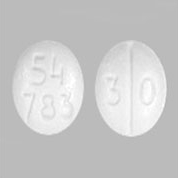Codeine

Pharmacology
Codeine is selective for the mu receptor, but with a much weaker affinity than morphine. The analgesic properties of codeine have been speculated to come from its conversion to morphine, although the exact mechanism of analgesic action is less well understood than the more potent members of the opiate family.
Codeine is absorbed from the gastrointestinal tract with maximum plasma concentration occurring 60 minutes post administration. Codeine is absorbed quickly from the GI tract and its first pass through the liver results in very little loss of the drug. This contrasts with morphine in which over 90% of the drug is metabolized in the first pass through the liver resulting in a considerable loss of potency when administered orally. This is why codeine is a common opiate in the relief of pain, the ease of oral administration.
Dihydrocodeine is an opioid analgesic. It is related to codeine and has similar analgesic activity. It is a stronger variant with more euphoric effect and consequently greater dependence potential. After oral doses peak concentrations of dihydrocodeine occur after about 1.2 to 1.8 hours; oral bioavailability is only about 20%, probably because of substantial first-pass metabolism in the gut wall or liver.
In its simple form it has a short half-life but longer acting controlled release tablets are available. One frequently cited reason it never really achieved the prominence its properties warranted as an opiate treatment option was not least because of a largely inaccurate perception at the Home Office that the tablet form is frequently crushed and injected. The usual formulation is dihydrocodeine tartrate.
The adverse effects codeine and dihydrocodeine are similar to other opioid analgesics; nausea, vomiting, constipation, drowsiness, and confusion; tolerance to these (except constipation) generally develops with long term use. Dry mouth, dizziness, sweating, facial flushing, headache, restlessness, changes of mood, sleep problems and miosis also occur. Raised intracranial pressure occurs in some patients/users. It can cause intense skin irritation. The main difficulty regularly reported, other than dependence, is that codeine, is that it is painfully constipating and can suppress the libido.
In the United Kingdom, neat codeine and higher-strength codeine formulations - such as 30/500 co-codamol (where 30 mg of codeine phosphate is combined with 500 mg paracetamol) are prescription-only medicines (POM). Lower-strength combinations, such as 8/500 (various brands) or 12.8/500 (Panadol Ultra, Solpadeine Plus and others) are available as pharmacy medicines over the counter. Codeine is also available combined with Ibuprofen; a common formulation is 12.8 mg codeine alongside 200 mg Ibuprofen.
Codeine Phosphate:
(POM) Tabs 15mg, 30mg, 60mg
Syrup codeine phosphate 25mg/5mL
Codeine Linctus 15mg/5mL (available as sugar free)
Can be sold to public if max. single dose does not exceed 5mL (not prescription)
Injection (CD) Codeine phosphate ampoules 60mg/1mL
Dihydrocodeine Tartrate:
(POM) Tabs: 30mg, DF118 Forte 40mg (POM)
DHC Continus (Modified Release) 60mg, 90mg, 120mg
Injection (CD) Dihydrocodeine tartrate ampoules 50mg/1mL (very rare)
Under the Misuse of Drugs Act and the Prescription Only Medicines (Human Use) Order 1997, there are provisions for small quantities of these controlled drugs to be included in non-prescription medicines and sold through pharmacies only. They may include doses of up to 25.6 mg codeine phosphate (ie, 12·8 mg per tablet for a two- tablet dose) and up to 14.92 mg DHC tartrate (ie, 7.46 mg per tablet for a two- tablet dose).
